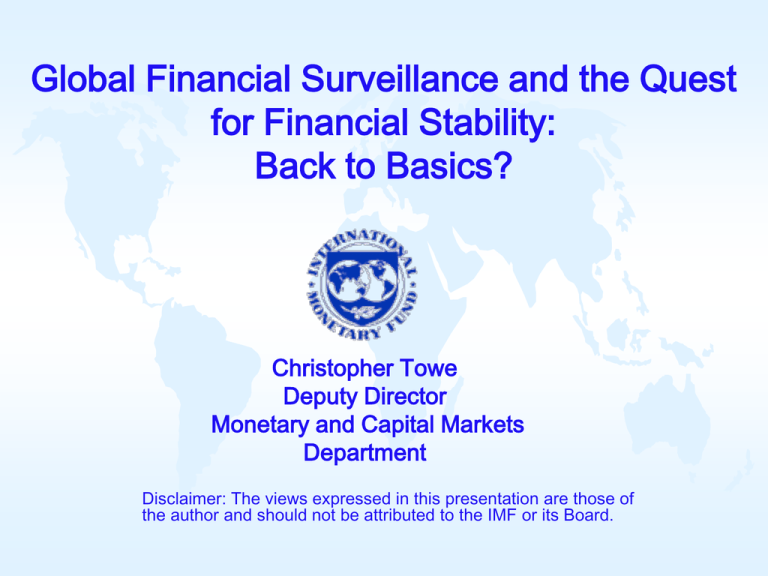Chris Towe (IMF) (234 KB )
advertisement

Global Financial Surveillance and the Quest for Financial Stability: Back to Basics? Christopher Towe Deputy Director Monetary and Capital Markets Department Disclaimer: The views expressed in this presentation are those of the author and should not be attributed to the IMF or its Board. Outline Will try to complement other speaker and panelists' remarks Will focus principally on how multilateral agencies—especially the IMF—are responding to the crisis And will try to flag some issues that we—the international community— still need to work hard on 2 What are we doing? The IMF, in particular, is going “back to basics” including by: redesigning our core mandate for multilateral and bilateral surveillance Redesigning our instruments for providing emergency liquidity 3 In our surveillance… Going “back to basics” means “ruthless truth telling” The crisis drove home: Warnings were unclear Policy messages not prioritized Misunderstanding of transmission channels Policy impact was limited 4 So how are we responding? Policy messages are becoming more forthright And coordination between agencies being enhanced Takes advantage of gains from trade (IMF, FSB, BIS) Tools are being strengthened IMF/FSB Early Warning Exercise IMF/WB Financial Sector Assessment Program becoming more risk and analytically focused Surveillance of systemically important institutions (not just countries) Methodologies for both identifying systemically important institutions Designing and promoting prudential norms to internalize externalities 5 Our lending facilities are also going “back to basics”… IMF lending facilities have been significantly expanded Trying to keep pace with global capital markets Re-establishes IMF mandate as international lender of last resort Adapted our conditionality framework New Flexible Credit Line relies on “ex ante” conditionality and helps reduces moral hazard Other facilities have also been streamlined “Structural” performance criteria have been eliminated 6 What will be the challenges? 1. 2. 3. 4. 5. 6. Candor v. effectiveness Maintaining interest in tail events Blurred accountability Cross-border cooperation Information gaps Deciding on the acceptable level of systemic risk 7 What will be the challenges? 1. Trade-off between public candor and effectiveness Long worried that outspokenness undermines authorities’ willingness to engage and seek advice But this concern is (more often than not) is outweighed by: The greater impact that candid and public messages can bring And the critical need to demonstrate that the Fund and others are impartial 8 What will be the challenges? 2. Maintaining policymakers' interest in low probability tail events By definition, these events are unlikely to materialize Undermines the credibility of the risk manager Requires that stridency is consistent with likelihood/potential severity of impact of risk But, just as in a bank, the culture of policymaking has to value risk management True both nationally and internationally 9 What will be the challenges? 3. The danger of blurred accountability The IMF’s original mandate was as the preeminent global systemic risk regulator But the number of actors has grown Large number of actors risks: E.g., BIS, FSB, OECD, standard-setters, G7, G20, etc. Lack of clarity about institutional responsibility Conflicting messages Loss of attention by policy makers Steps taken to clarify IMF/FSB roles recently and close cooperation will be vital 10 What will be the challenges? 4. Encouraging/enforcing cross-border cooperation Lehman Brothers/Icelandic banks illustrates the need Absent action on this front, risk of retreat to financial autarky and barriers to international transactions and markets Goals should include: Internationally harmonized bank resolution and bankruptcy regimes Clarity with regard to burden sharing (deposit insurance and beyond) Supervisory cooperation that extends beyond MOUs (and even colleges) But at the global level, progress is likely to be slow Focus instead on ensuring consistent standards E.g., FSB principles for cross border crisis management And (perhaps) supporting coalitions of the willing I.e., encouraging regional approaches to cooperation 11 What will be the key challenges? 5. Filling information gaps Crisis illustrated massive gaps at the national and multi-national levels On- and off-balance sheet exposures of banks Level of risk associated with CDOs and CDS Connectivity Given magnitude of cross-border flows and spillover risks… Agencies such as BIS and IMF need to take a leadership role in requiring internationally consistent data E.g., strengthen BIS international bank flow data and IMF “Financial Sector Indicators” But will require major effort and cooperation of national authorities 12 What will be the challenges? 6. Deciding on the acceptable level of systemic risk Too much stability is boring! Regulation is costs and could weigh excessively on innovation and investment So decisions on higher capital, liquidity, etc. charges need to be well calibrated And… Better to build formula based norms that are countercyclical, in order to keep average cost low But Do not rely too much on “rules” Regulators must be held accountable for exercising “discretion” to tighten when vulnerabilities appear E.g., Pillar II 13 THE FINANCIAL SECTOR ASSESSMENT PROGRAM Christopher Towe Deputy Director, Monetary and Capital Markets Department Global Financial Surveillance and the Quest for Financial Stability: Back to Basics? Christopher Towe Deputy Director, Monetary and Capital Markets Department Disclaimer: The views expressed in this presentation are those of the author and should not be attributed to the IMF or its Board.







